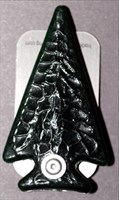| Trackable Options |
 Found this item? Log in.
Found this item? Log in. |
 Printable information sheet to attach to Texana-Caddo TB02
Print Info Sheet
Printable information sheet to attach to Texana-Caddo TB02
Print Info Sheet |
| There are 2 users watching this listing. |
This is not collectible.
Please drop this item in rural OR Premium Member Only caches. Do not place it in an urban cache or abandon it at a caching event. Transport the bug in the original plastic bag for as long as the bag lasts; the bag keeps the trackable clean and prevents tangling with other items. Otherwise, take the travel bug anywhere you wish. No permission is needed to leave the U.S.
Photos in the travel bug logs are appreciated. I will be re-post them here, where they can be seen by other cachers.

This travel bug is one of several commemorating the major Indian tribes native to the land of what is now Texas from historic times (in general from the 18th century). The term tribe applies to peoples who spoke the same language and and shared the same customs and rituals. There are many other tribes and lesser-known bands occupying Texas than are acknowledged here. Some of these were never large enough to be considered a major tribe, others ceased to exist before the 1700s (assimilation and disease), some these were driven into the region by European-American expanansion (Cherokee, Kickapoo, Tigua, Alabama, others), and finally some could not be classified because they were never seen by keen observers while their language and ways were still intact. The Cohuiltecans of south Texas fit all these criteria. It would be a mistake to assume that these tribes are insignificant in the history of Texas. Below is a brief narrative of the presence of one major tribe from historic times. Much of the information is from the online Texas Almanac.
Before the middle of the nineteenth century the term Caddo denoted only one of at least twenty-five distinct, but closely affiliated groups centered around the Red River in Texas, Arkansas, Louisiana, and Oklahoma. The term derives from the French abbreviation of Kadohadacho, a word meaning "real chief" or "real Caddo" in the Kadohadacho dialect.
The first European description of the Caddo peoples came in 1542 from diarists traveling with the De Soto expedition. The Spanish described several of the Caddo groups as having dense populations living in scattered settlements and having abundant food reserves of corn.
At the time of sustained European (Spanish and French) contact with the Caddo groups in the late seventeenth century, Caddo peoples lived on the Red River and in East Texas. European populations-living in missions, ranches, and trading posts-increased throughout the eighteenth and into the early nineteenth century in the Red River valley and in the vicinity of Natchitoches, Louisiana and Nacogdoches, Texas. While epidemics between 1691 and 1816 greatly reduced Caddo populations, Caddo peoples participated in the fur trade, traded guns, horses, and other items to Europeans and other Indians, and developed new trade and economic networks.
While the Hasinai Caddo groups continued to live through the 1830s in their traditional East Texas homeland in the Neches and Angelina River valleys, the Kadohadacho groups moved off the Red River in the 1790s to get away from Osage depredations and slave-raiding. Their new settlements were between the Sabine River and Caddo Lake, generally along the boundary between the territory of Louisiana and the province of Texas. Most of the Kadohadachos remained in the Caddo Lake area until about 1842, although
The loss of Caddoan lands in Louisiana in 1835 and increased the size of the Caddo Lake settlement while other displaced Caddos moved to the Brazos River in north central Texas. By the early 1840s, all Caddo groups had moved to the Brazos River area to remove themselves from Anglo-American repressive measures and colonization efforts. They remained there until they were placed on the Brazos Indian Reservation in 1855, and then in 1859 the Caddos (about 1,050 people) were removed to the Washita River in Indian Territory (now western Oklahoma).
During the Civil War most of the Caddo groups abandoned the Indian Territory and resettled in southern and eastern Kansas, but they moved back to the Wichita Reservation in 1867. By 1874 the boundaries of the Caddo reservation were defined, and the separate Caddo tribes agreed to unite as the unified Caddo Indian Tribe. The Caddo peoples continue to live in western Oklahoma, primarily in Caddo County near the Caddo Indian Tribe's Tribal Complex, outside Binger, Oklahoma.